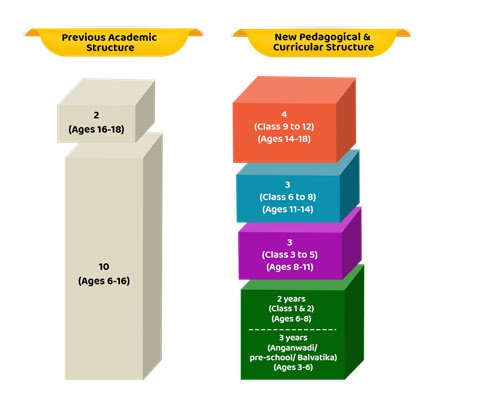New Education Policy, 2020
Why in news:
- The Parliament Standing Committee on Education tabled a report during the special session of Parliament on the “Implementation of the National Education Policy (NEP), 2020 in Higher Education.”
- The Committee appreciated the way the NEP was implemented in Jammu and Kashmir.
Main features of NEP, 020:
- Ensuring Universal Access at All Levels of schooling from pre-primary school to Grade 12;
- Ensuring quality early childhood care and education for all children between 3-6 years;
- New Curricular and Pedagogical Structure (5+3+3+4);
- No hard separations between arts and sciences, between curricular and extra-curricular activities, between vocational and academic streams;
- Establishing National Mission on Foundational Literacy and Numeracy;
- Emphasis on promoting multilingualism and Indian languages; The medium of instruction until at least Grade 5, but preferably till Grade 8 and beyond, will be the home language/mother tongue/local language/regional language.
- Assessment reforms – Board Exams on up to two occasions during any given school year, one main examination and one for improvement, if desired;
- Setting up of a new National Assessment Centre, PARAKH (Performance Assessment, Review, and Analysis of Knowledge for Holistic Development);
- Equitable and inclusive education – Special emphasis given on Socially and Economically Disadvantaged Groups (SEDGs);
- A separate Gender Inclusion fund and Special Education Zones for disadvantaged regions and groups;
- Robust and transparent processes for recruitment of teachers and merit based performance;
- Ensuring availability of all resources through school complexes and clusters;
- Setting up of State School Standards Authority (SSSA);
- Exposure of vocational education in school and higher education system;
- increasing GER in higher education to 50%;
- Holistic and Multidisciplinary Education with multiple entry/exit options;
- NTA to offer Common Entrance Exam for Admission to HEIs;
- Establishment of Academic Bank of Credit;
- Setting up of Multidisciplinary Education and Research Universities (MERUs);
- Setting up of National Research Foundation (NRF);
- ‘Light but Tight’ regulation;
FINDINGS OF THE REPORT:
- The report noted that of the 1,043 universities functioning in the country, 70% are under the State Act and that 94% of students are in State or private institutions with just 6% of students in Central higher educational institutions, stressing the importance of States in providing higher education.
- The panel said that by 2030, every district in the country should have at least one multidisciplinary HEI and that the Gross Enrolment Ratio in higher education, including vocational education, should be increased from 26.3% in 2018 to 50% by 2035.
RECOMMENDATIONS OF THE COMMITTE:
The panel asked the Union Government and the State Governments to take actions such as:
- earmarking suitable funds for the education of Socially and Economically Disadvantaged Groups (SEDGs),
- setting clear targets for higher Gross Enrolment Ratio for SEDGs,
- enhancing gender balance in admissions to HEIs,
- providing more financial assistance and scholarships to SEDGs in both public and private HEIs,
- making admission processes and curriculum more inclusive,
- increasing employability potential of higher education programmes and for developing more degree courses taught in regional languages and bilingually.
- The panel also recommended specific infrastructural steps to help physically challenged students and a strict enforcement of all no discrimination and antiharassment rules.
- The Committee suggested improving the effectiveness and impact of the Higher Education Financing Agency (HEFA) in funding HEIs.
- It asked the HEFA to diversify its funding sources beyond government allocations and explore partnerships with private sector organizations, philanthropic foundations, and international financial institutions.
- It recommended reviewing and adjusting the interest rates on loans provided by HEFA “to make them more competitive and affordable” for HEIs.
- The panel said that Indian institutions were likely to face several issues in implementing the multiple entry and multiple exit (MEME) system.
- The panel said while the MEME looked like a flexible system, which was being operated by Western educational institutions effectively, it might not work well in the country.
- If institutions allow MEME, it would be very difficult for the institutions to predict how many students would exit and how many would join midway. Since institutions would not know the in and out traffic, it will certainly disturb the pupil teacher ratio.
Way forward:
- A New Education Policy aims to facilitate an inclusive, participatory and integrative approach which needs to take into consideration field experiences, empirical research, stakeholder feedback, as well as lessons learned from best practices.
- There should be competitive and collaborative approach between states and Union for the successful implementation of NEP.
Syllabus: GS 2; Education
SOURCE: THE HINDU




